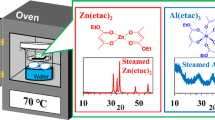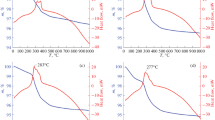Abstract
Zinc bis(ethyl acetoacetate) (Zn(etac)2) was steamed with water vapor at various temperatures (40–70 °C). A portion of the ethyl acetoacetato group was dissociated upon steaming Zn(etac)2 at 40 °C. However, zinc oxide (ZnO) was not formed. On steaming at 50 °C, the ethyl acetoacetato group was completely removed. The Zn(etac)2 steamed at 50 °C was attributed to the wurtzite ZnO, but impurity was contaminated. Zn(etac)2 steamed at 60–70 °C was converted into pure wurtzite ZnO powder. The Zn(etac)2 could be decomposed by water vapor; interestingly, wurtzite ZnO powder was formed from Zn(etac)2 by steaming treatment at low temperature. Moreover, a Zn(etac)2 solution was coated on a glass substrate followed by steaming at 70 °C; a thin film showed a transparency and a flat surface.

When zinc bis(ethyl acetoacetate) (Zn(etac)2) undergoes a steaming treatment at 60–70 °C, a wurtzite ZnO powder was formed.
Highlights
-
Zn(etac)2 was prepared by the reaction of diethylzinc with ethyl acetoacetate.
-
Zn(etac)2 was decomposed in hot water vapor.
-
Zn(etac)2 was converted into wurtzite ZnO powder in water vapor at 60–70 °C.




Similar content being viewed by others
References
Zhu L, Zeng W (2017) Room-temperature gas sensing of ZnO-based gas sensor: a review. Sens Actuators A Phys 267:242–261
Skompska M, Zarębska K (2014) Electrodeposition of ZnO nanorod arrays on transparent conducting substrates–a review. Electroshim Acta 127:467–488
Qi K, Cheng B, Yu J, Ho W (2017) Review on the improvement of the photocatalytic and antibacterial activities of ZnO. J Alloy Compd 727:792–820
Ong CB, Ng LY, Mohammad AW (2018) A review of ZnO nanoparticles as solar photocatalysts: synthesis, mechanisms and applications. Renew Sust Energ Rev 81:536–551
Kołodziejczak-Radzimska A, Jesionowski T (2014) Zinc oxide—from synthesis to application: a review. Materials 7:2833–2881
Kim EH, Lee DH, Chung BH, Kim HS, Kim Y, Noh SJ (2007) Low-temperature growth of ZnO thin films by atomic layer deposition. J Korean Phys Soc 50:1716–1718
Yoshino K, Ide A, Mochihara A, Ogomi Y, Shen Q, Toyoda T, Hayase S (2016) Low-temperature growth of porous and dense ZnO films for perovskite solar cells on ITO substrate. Chem Lett 45:176–178
Ambrožič G, Škapin SD, Žigon M, Orel ZC (2010) The synthesis of zinc oxide nanoparticles from zinc acetylacetonate hydrate and 1-butanol or isobutanol. J Coll Interface Sci 346:317–323
Nose Y, Yoshimura T, Ashida A, Uehara T, Fujimura N (2012) Low temperature growth of ZnO thin films by non-equilibrium atmospheric pressure N2/O2 plasma and the growth morphology of the films. Zairyo 61:756–759
Yamada K, Chow TY, Horihata T, Nagata M (1988) A low temperature synthesis of zirconium oxide coating using chelating agents. J Non-Cryst Solids 100:316–320
Gunji T, Nagao Y, Misono T, Abe Y (1991) Studies on the synthesis of polymetalloxanes and their properties as a precursor for amorphous oxide (Part 6). Nippon Seramikkusu Kyokai Gakujutsu Ronbunshi 99:178–179
Ohtaki N, Yoshino K (2003) Method for producing zinc acetylacetonate monohydrate. Japan Patent JP 2003-342222A
Hayami R, Tsukada S, Abe Y, Gunji T (2016) Synthesis and properties of b-diketonato metal complexes as catalysts for the synthesis of polyurethane. Mater Technol 34:11–17
Hayami R, Endo N, Abe T, Miyase Y, Sagawa T, Yamamoto K, Tsukada S, Gunji T (2018) Zinc–diethanolamine complex: synthesis, characterization, and formation mechanism of zinc oxide via thermal decomposition. J Sol–Gel Sci Technol 87:743–748
Grummitt O, Perz J, Mehaffey J (1972) Zinc ethyl acetoacetate. Org Prep Proc Int 4:299–300
Lide DR (2004) CRC handbook of chemistry and physics, 85th edn. CRC Press, Boca Raton, USA
Abe Y, Kudo T, Tomioka H, Gunji T, Nagao Y, Misono T (1998) Preparation of continuous zirconia fibres from polyzirconoxane synthesized by the facile one-pot reaction. J Mater Sci 33:1863–1870
Tezuka Y, Ogura T, Kawaguchi S (1969) p-Allylie coordination of ethyl acetoacetate to palladium(II). Bull Chem Soc Jpn 42:443–446
Niven ML, Thornton DA (1980) Band assignments in the infrared spectrum of zinc acetylacetonate monohydrate by 18O-, 68Zn-, and 64Zn-labelling. Spectrosc Lett 13:419–425
Bender ML, Figueras J (1953) The infrared spectra of enolate ions. J Am Chem Soc 75:6304–6304
Morita H, Nakamura Y, Kawaguchi S (1972) Some metal complexes containing ethyl acetoacetate or ethyl malonate as a neutral ligand. Bull Chem Soc Jpn 45:2468–2472
Winiarski J, Tylus W, Winiarska K, Szczygieł I, Szczygieł B (2018) XPS and FT-IR characterization of selected synthetic corrosion products of zinc expected in neutral environment containing chloride ions. J Spectrosc 2018 2079278:14
Srivastava OK, Secco EA (1967) Studies on metal hydroxy compounds. II. Infrared spectra of zinc derivatives e-Zn(OH)2, b-ZnOHCl, ZnOHF, Zn5(OH)8Cl2, and Zn5(OH)8Cl2·H2O. Can J Chem 45:585–588
Sithole J, Ngom BD, Khamlich S, Manikanadan E, Manyala N, Saboungi ML, Knoessen D, Nemutudi R, Maaza M (2012) Simonkolleite nano-platelets: synthesis and temperature effect on hydrogen gas sensing properties. Appl Surf Sci 258:7839–7843
Andrés-Vergés M, Serna CJ (1988) Morphological characterization of ZnO powders by X-ray and IR spectroscopy. J Mater Sci Lett 7:970–972
Tanigaki T, Kimura S, Tamura N, Kaito C (2002) A new preparation method of ZnO cubic phase particle and its IR spectrum. Jpn J Appl Phys 41:5529–5532
Hayashi S, Nakamori N, Kanamori H, Yodogawa Y (1979) Infrared study of surface phonon modes in ZnO, CdS and BeO small crystals. Surf Sci 86:665–671
Hayashi S, Nakamori N, Kanamori H (1979) Generalized theory of average dielectric constant and its application to infrared absorption by ZnO small particles. J Phys Soc Jpn 46:176–183
Tokumoto MS, Pulcinelli SH, Santilli CV, Briois V (2003) Catalysis and temperature dependence on the formation of ZnO nanoparticles and of zinc acetate derivatives prepared by the sol–gel route. J Phys Chem B 107:568–574
Zhao L, Miao J, Wang H, Ishikawa Y, Feng Q (2009) Synthesis and exfoliation of layered hydroxide zinc aminobenzoate compounds. J Ceram Soc Jpn 117:1115–1119
Acknowledgements
Prof. Koji Arimitsu and Mr. Kouta Ooki (Tokyo University of Science) are acknowledged for their assistance with the thickness measurement. Dr. Kazuhiro Sayama (AIST) is greatly acknowledged for providing the AFM instrumentation.
Author information
Authors and Affiliations
Corresponding author
Ethics declarations
Conflict of interest
The authors declare that they have no conflict of interest.
Additional information
Publisher’s note: Springer Nature remains neutral with regard to jurisdictional claims in published maps and institutional affiliations.
Supplementary Information
Rights and permissions
About this article
Cite this article
Hayami, R., Endo, N., Miyase, Y. et al. ZnO formation through decomposition of zinc bis(ethyl acetoacetate) by steaming treatment. J Sol-Gel Sci Technol 91, 255–260 (2019). https://doi.org/10.1007/s10971-019-05043-x
Received:
Accepted:
Published:
Issue Date:
DOI: https://doi.org/10.1007/s10971-019-05043-x




